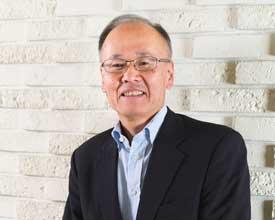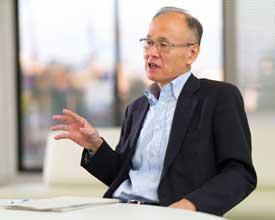

01/30/2017

What happens when you bring mathematicians and materials scientists under one roof? The Advanced Institute for Materials Research (AIMR) at Tohoku University is five years into a bold experiment that uses mathematics to glean insights into materials. AIMResearch talks to Yasumasa Nishiura — an applied mathematician and unit leader of the AIMR’s Mathematical Science Group — about the unexpected results from the AIMR’s radically new way of thinking.
AIMResearch: What unique perspective does mathematics bring to materials science?
Nishiura: The language of mathematics brings new concepts and viewpoints to the understanding of materials science. Without it, some material properties cannot be described explicitly.
Mathematics is also a very powerful way to overcome rigid and obsolete conceptual frameworks. A typical example is chaos theory, a field of study in mathematics that tries to predict the unpredictable. Chaotic systems behave in unexpected ways and yet are entirely controlled by their initial conditions. About half a century ago, nobody knew about this concept of chaos, so they just threw data away because it was too ‘noisy’ and didn’t contain any definable structures. But today, researchers recognize that even very noisy-looking data sometimes have internal structures that contain extractable information. To do that, they need mathematical concepts like chaos. Otherwise, they’re just wandering in the dark.
AIMResearch: What are some interesting results that have come out of combining materials science and mathematics at the AIMR?
Nishiura: We have applied concepts in the well-established mathematical field of topology, which studies the twists and turns of shapes, to materials science. Topology offers a new framework for understanding amorphous structures that lie between the perfectly ordered arrangements of crystals and random structures like liquids. More specifically, we have used an analytical technique for uncovering geometries hidden in large data sets, called persistent homology, to analyse structures that nobody has succeeded in characterizing, and to pin down the definition of the term amorphous.
Related to topology is an emerging field in materials science known as spintronics. Conventional electronics uses electrons to carry energy and information. In contrast, spintronics relies on electron spin. Many aspects of spintronics can be explained by a mathematical framework used to study very advanced geometries known as K-theory. Take, for example, promising materials in the field of spintronics known as topological insulators, which are insulators on their inside but conductors on their surface. K-theory can clarify why this phenomenon is so robust in topological insulators.
Another area I am deeply involved in is self-organization processes. A standard way of fabricating nanomaterials is from the top down — gradually chipping away at a solid block using techniques such as nanolithography. The alternative approach starts from the bottom up — constructing something from nothing. Self-organization is one such technique, in which basic building blocks are left to spontaneously form larger building blocks. It lets nature do its work. In materials science, self-organization is a fertile but undeveloped area. My work specifically involves confining polymers that are extremely averse to each other in very tiny spheres. The polymers seek to decrease the free energy and, in the process, form interesting patterns. We have developed a qualitative mathematical model that can be used to control the size and morphologies of the patterns that pop up, which has wide applications including in the medical sciences. For example, structured particles could be used to test immunity by employing reactions between antibodies and antigens.
Finally, we have applied a mathematical discipline known as discrete differential geometry to explore the design of carbon structures. Discrete differential geometry structures contain a distinct number of elements, such as atoms. We have used its concepts to make many interesting structures from carbon atoms, such as large carbon cages with 20-sided polyhedrons. We have even placed molecules inside these cages.

AIMResearch: Can mathematicians also learn from materials scientists?
Nishiura: Yes, collaboration is not just one way; it goes both ways. We mathematicians often get very fresh and intriguing feedback from experimentalists. This is quite new for us and has led to the generation of new mathematics, or at least the discovery of new problems.
At the AIMR, such two-way feedback is greatly accelerated. For example, we have explored together the dynamical evolution of material structures, which demands generalizing the concept of persistent homology in space and time. We sit very close to each other and work together in one building. As far as I am aware, the AIMR is the only institute in the world where this happens in materials science.
AIMResearch: What are some challenges you face?
Nishiura: Overcoming cultural differences is not easy. Mathematicians and materials scientists have different answers to questions about what the important and interesting aspects of a problem are and what they value most. They also have very different styles of working. Experimental laboratories are more hierarchical in structure and require a lot of space and money since they need expensive facilities and large teams of technicians. But mathematicians are more private. We like to discuss, but we also need periods of solitude. At the AIMR, we have been given the time to warm up to each other.
AIMResearch: What policies has the AIMR introduced to facilitate this collaboration?
Nishiura: Five years ago, we set ourselves three main targets: non-equilibrium structures, topological structures and hierarchical structures. A healthy mix of materials scientists and mathematicians work together to achieve these goals.
We also established the Interface Unit, a group of researchers who act as free electrons, with the freedom to choose which projects they want to get involved in. They are young and ambitious — younger people tend to be more flexible and curious.
Another characteristic of the group is its heterogeneity. The researchers have backgrounds in applied mathematics, physics, statistics, information science, computer science and modeling, as well as physical and theoretical chemistry. This is important because you don’t know a priori what tools or methodologies will be important in materials science. Heterogeneity catalyzes serendipitous discoveries.
AIMResearch: What areas do you expect the AIMR to further develop in the coming years?
Nishiura: Experiments today generate huge amounts of data, which has fueled an entire field of science devoted to extracting knowledge from large data sets. Traditionally, this has involved processing information using statistics, computer science and information technology. In materials science, this approach is characterized by the popular phrase materials informatics. Mathematics can help to explain how these information processing systems work.
AIMResearch: Could the AIMR model be applied to other fields besides materials science?
Nishiura: Yes. That is the most important message that the scientific community should take from the AIMR. In just five years, we have become extremely successful. Our success springs from the nature of mathematics. Since mathematical methods treat only the relations between objects and are independent of material properties, they have great potential to be applied to other disciplines besides materials science. The AIMR is a sort of trial for what happens when you inject mathematics into materials science. We have formed some interesting collaborations and obtained some interesting results. So why not try injecting mathematics into other disciplines?